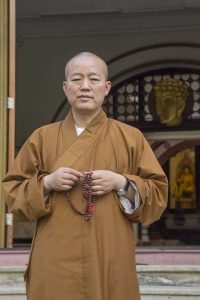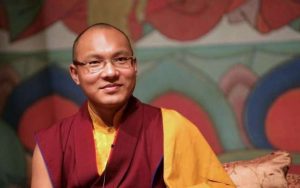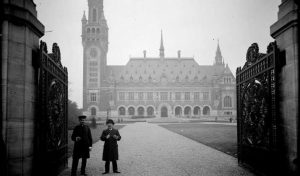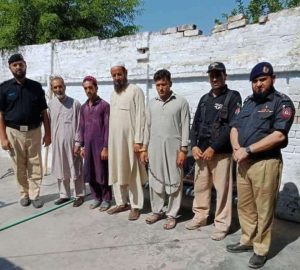The conservation of Buddhist cultural heritage is a multifaceted endeavor; an undertaking of considerable nuance and sensitivity. While the Buddhadharma teaches us the reality of impermanence and cautions against attachment to material forms, it also emphasizes the value of lineage, transmission, and the skillful use of outer forms to cultivate inner awakening. Seen through the lens of this seeming paradox, Buddhist heritage conservation—sincerely practiced—thus becomes its own spiritual exercise: one of reverence and mindfulness that seeks to honor the past, serve the present, and protect expressions of the Dharma for the benefit of future generations.
The challenge for conservators, therefore, lies in navigating this subtle middle way that acknowledges the sanctity of these cultural touchstones—not merely as artifacts to be enshrined but as testaments to a living tradition that continues to guide practitioners toward liberation. This series of essays on the Tibetan Buddhist heritage of Tsum Valley has documented an ongoing conservation initiative in Nepal as it maintains the delicate balance between preserving sacred artifacts, while embracing the very impermanence they so eloquently express; between preserving the past while looking to the future.
Tsum Valley is one of Nepal’s lesser-known jewels; an ancient Buddhist region with a long and firmly rooted history of Dharma practice. Today, the valley is a protected refuge where the time-honored Buddhist traditions of the Kagyu and Nyingma schools of Tibetan Buddhism continue to thrive. Officially opened to foreign visitors in 2008, this once-secluded region now faces the challenge of balancing the conservation of its rich cultural and spiritual heritage while accommodating the growing ingresses of modern tourism.
The Mahayana and Vajrayana traditions of the Himalayas are deeply embedded in Tsum Valley, as amply evidenced by the unique and historic Buddhist temples, monasteries, and other sanctified landmarks that punctuate the rugged Himalayan landscape—among them a revered cliff-face grotto in which the great Tibetan siddha Milarepa himself is believed to have meditated. And it is in this valley that a remarkable initiative—the Tsum Preservation Project—is working for the benefit of the local communities, for the benefit of Nepal’s precious Buddhist heritage, and for the benefit of sustaining these time-worn expressions of the Buddha’s teachings.
The Tsum Preservation Project is being manifested by Treasure Caretaker Training (TCT), a US-headquartered non-profit organization dedicated to working closely with nuns and monks to help ensure the preservation of the world’s remaining Buddhist treasures and relics. TCT is led by professional conservator Ann Shaftel, a fellow of the International Institute for Conservation and the American Institute for Conservation, and a member of the Canadian Association of Professional Conservators. Since 1970, Ann has worked on the conservation of Buddhist art across the world, cooperating with monasteries, Dharma centers, museums, and universities.
Parts four and five of this series of articles recount my second visit to Tsum Valley in May 2024, when Ann and TCT’s multinational team of conservators worked at Rachen Nunnery to preserve a collection of historic clay votive offerings, or tsa-tsas, depicting the bodhisattva of compassion Avalokiteshvara (Tib: Chenrezig). In this installment, we travel higher up the sacred valley in the company of senior TCT conservator Craig Deller and under the expert guidance of the local khenpo, Tenzin Lhundrup Lama. Our mission: to survey several more living Buddhist heritage sites, and assess the potential for documenting and conserving the rare artifacts, sculptures, texts, thangkas, and painted panels housed within.
Eager to encounter for ourselves some of the fabled secrets that Tsum Valley continues to protect, we departed the relative comfort of Rachen Nunnery (see part four) and ascended Tsum Valley on foot, meandering toward the Tibetan border and climbing to an eventual elevation of more than 3,900 meters under the watchful gaze of the surrounding guardian summits. This splendid remoteness, however, is also one of the many hurdles that stand in the way of attempting such specialized conservation work: access to the artifacts must be undertaken either on foot, by pony, or, if the terrain allows, by helicopter.
During our ascent of Tsum, Khenpo Tenzin delved into his family’s deep connection with the hallowed landscape, and what it means for him and the local communities. “We have a very brief family chronicle that was composed in the 17th century. . . . Our grandfather was the 19th generation, our father was 20th, and now we are the 21st generation to live here in Tsum,” he explained.
Khenpo Tenzin, 44, the nephew of Sherab Tander Rinpoche, has spent considerable time practicing in solitary retreat in the valley’s hermitages, and has also researched assiduously and written on Tsum’s Buddhist history. His familial roots extend back to a time when the valley was a contiguous part of the Tibetan Himalaya, when movements were unhindered by today’s restrictive political boundaries.
“In former times, there were two local administrations: one was the political administration and the other was for religious affairs,” Khenpo Tenzin elaborated. “For anything related to Buddhist activities we have an institution known as the labrang (Tib: བླ་བྲང་), with different villages falling under different labrangs. Whenever the villages had any Buddhist-related affairs or concerns, they would turn to their labrang.
“In upper Tsum we have three labrangs. In lower Tsum we have four. Our family labrang has been a religious institution since the distant past—always a hereditary institution passing from father to son. Ours is considered the largest because it encompasses seven villages, and so we’re also responsible for all of the gompas in these seven villages, which number 24 in total.
“We still follow the traditions of the past for all the prayer pujas and other rituals at the gompas,” he emphasized. “For example, for certain ceremonies we will visit each household, which will contribute a certain quantity of grains. The organizer will receive the grain contributions and arrange the puja. The organizers take turns, so that each and every household has an opportunity to participate.”
Notable among the venerated sites that Khenpo Tenzin brought us to survey are Chorten Ghangchub Namja (Chorten Gompa), the hillside Gongul Rinchen Gompa, and Gonhok Sangak Phodrang. Higher still, lying within a stone’s throw of the sensitive border with Tibet, are the high-altitude monastic hermitages of Dedron Nunnery and finally Rigang Gompa at 3,955 meters, which were the most anticipated stops on our conservation itinerary.
“I lived in Tsum until I was eight years old, then I was sent away to school in Kathmandu, which lasted until I was 19,” Khenpo Tenzin related during our journey. “After the age of 19, I went to Varanasi in India, where I studied Tibetan Buddhist philosophy. I completed my studies there in 2005. Afterward, I began working with my uncle teaching in his monastery. The monastery was very new then and he had a new monastic community, so I spent about nine years there, teaching and helping with the administration. During that time, whenever I had an opportunity, I began reading about the history of Tsum Valley and our labrang.
“While researching, I discovered important written sources and records—prior to that very few were known. There were two which were mainly about how the people came here from Tibet and established settlements, while the remainder were mainly drawn from biographies of various lineage masters. Many of the texts we uncovered were stored in Tsum, and others we retrieved from the national archives in Kathmandu. Some were shared by foreign friends who are scholars conducting their own research—they were able to supply me with texts to which I didn’t previously have access, and I was able to share my documents with them.
“Thus I was able to assemble many documents and compose a book on the history of Tsum. Some of our friends subsequently asked us to print copies of those textual sources, which were not easily available. We’ve printed five so far, and are in the process of printing another four,” he added.
“During the process of seeking out these original sources, we consulted catalogs of various written texts in Tsum. We also looked for texts hidden within the linings of old thangkas and paintings; some statues also have writings stored inside, so we were going through these as well. And it was during this process that I discovered how many of these original texts—and the artifacts that contained them—had been damaged by water and insects and other environmental factors. I quickly recognized the importance of urgent conservation action.”
Indeed, until the previous generation of the labrang lineages, all of the Buddhist hermitages had fallen into disrepair. At the request of the valley’s residents, Sherab Tander Rinpoche has, since the early 1990s, been working to re-establish the hermitages and guide the villagers with an eye toward the future. This work has involved rebuilding gompas and providing spiritual guidance for the monastics who serve the local communities. At present, three of the labrang’s hermitages have resident nuns, one of which is Dhedron Nunnery.
Resplendent in the thinner air of Tsum’s upper reaches, Dhedron Nunnery occupies a dramatic mountainside eyrie that overlooks the rock-strewn valley. The gompa is a 30-minute hike from the original Dhedron Nunnery, which was founded in 1236 by Lama Madun Reachen (1197–1265) as the first hermitage in the area. After being rebuilt, however, Dhedron Nunnery succumbed to a rockslide during Nepal’s devastating earthquake of 2015, and was subsequently relocated to a safer site nearby.
The original nunnery housed an impressive collection of statues, thangkas, texts, and painted wall panels, including images of exceptional rarity and great historical and spiritual significance. While a portion of these have been rehoused, others remain in storage in retreat rooms and other chambers that are still standing. Despite their inherent value, the gompa’s remoteness means that moving them is an arduous task, and one that risks further damaging these fragile relics.
“The old nunnery holds a collection of very nice wall paintings, but so far we have only been able to preserve very few,” Khenpo Tenzin lamented. “Now Dhedron doesn’t have as many wall panels as it once did. A number were heavily damaged by water and we were, unfortunately, unable to preserve all of them.”
As we explored the remarkable heritage collections stored in these venerated refuges, and pondering their histories, Khenpo Tenzin and Craig Deller examined potential strategies and discussed possible treatments for salvaging and preserving—or at the very least stabilizing—the remaining tantric artifacts. Yet the underlying questions remained: how best to bring the necessary equipment and conservator expertise to bear in such remote and dispersed locations; how to transport such fragile artifacts for treatment; and where to locate the conservators so that they could undertake their work. . . .
Following Khenpo Tenzin’s lead, we descended from Dhedron Nunnery, waded through the roiling blue glacial river that cleaves the valley, then scaled the valley’s opposite flank to the final stop on our survey: the monastic hermitage of Rigang. Although Rigang Gompa has been partially rebuilt, it is perhaps the most inaccessible of the sites we visited. Although it does not currently support any resident monastics, the gompa houses a not inconsiderable collection of images in need of attention.
“Our family are the custodians of many artifacts, so for some time I’ve been anxious to have them documented so that their existence can be recorded,” Khenpo Tenzin remarked. “Because we have so many sacred thankas, paintings, and statues, our first priority in talking with TCT was to discuss effective ways digitally document all these heritage items. We want to have them comprehensively documented so that we can ensure that they’re at least digitally preserved, and so that they always be traced if they are stolen or removed. This was our initial intention, because these artifacts belong here and once they’re lost, then the identity of the place is also lost.”
While the more accessible gompas on the valley floor, protected by attentive village communities, are easier to maintain on a day-to-day basis, the treasures they house are no less vulnerable to damage and destruction—atmospheric and environmental changes, natural disasters, water ingresses, insect infestations, and more, all pose unique existential threats to the heritage of this remote region. At higher altitudes, in deliberately isolated settings, the difficulty of addressing these already-challenging problems becomes many times more complicated. Compounding these ongoing dilemmas of impermanence is the concurrent withering of the traditional arts, practices, trades, and knowhow that produced them and sustained them in generations past.
“At one time Tsum had its own woodblock printing house, which is very rare to find in the Nepal region and in Himalayan regions,” Khenpo Tenzin recalled. “This illustrates how developed Tsum Valley was in the past in terms of religious affairs, and how advanced the people were in terms of traditional arts and Buddhist practice. As a result, we can find old texts such as cham manuals, meditation guides, ritual instructions, astrological texts, and a wealth of fine thangkas that give a very clear picture of the high level of cultural development in Tsum in those days.
“Nowadays, in the whole of Tsum Valley, you cannot find a single thangka painter. There are a few from here who now live in Kathmandu; they are trained there, but the tradition here in Tsum has already been lost. The texts also cover traditional Tibetan medicine because there used to be many traditional Tibetan doctors in Tsum. Now there are no practitioners, aside from my sister.
“From the artifacts and texts that we preserve here, we can gain insights and perspectives into how our ancestors engaged with and practiced traditional arts: how they painted thangkas; how they wrote and printed sacred texts; how they carved mantras into stone.
“You’ve walked through this valley and seen the enormous number of carved mani stones—these are all monuments to the devotion of our ancestors. Until recently, there was still one stone carver in Tsum. He passed away a few years back, and now in the entire valley there is not a single stone carver.”
“Tsum Valley has a very long and rich history of Buddhist culture, yet so many expressions of this culture have been lost over the years due to the activities of what we might describe as ‘art mafias,’” Khenpo Tenzin acknowledged. “Many sacred items were stolen to be sold off in Kathmandu. From there they end up in various places all over the world—especially the metal statues, which have already vanished from most of our monasteries. The temples inside the villages are generally safer, but the more remote monasteries have not fared so well. Even many beautiful thangkas have been stolen.
“And yet, because of our long history, so many of our Buddhist traditions are still alive here. Numerous Buddhist rituals, festivals, and celebrations continue to be practiced and observed throughout the year at our monasteries. And I would like to see that continue.
“Each monastery conducts various types of rituals; they each have their own practices and retreats. Of course the male and female monastics have their own practices, and even the laypeople practice, especially during the winter months. As such, we have to focus on educating people today and raising awareness about how their ancestors lived and practiced.”
Khenpo Tenzin paused to reflect before continuing: “Nowadays, the residents of the valley are more interested in modern ways of doing things, and as a result many of the ancient ways have been neglected and lost. Preserving our remaining artifacts has real value as they are reflections of our heritage and records of our past, and we want to educate people about how to practice and sustain the old ways as much as possible.”
Beside the tumbling glacial waters that had carved Tsum Valley from the same impenetrable rock on which I sat, I pondered the seeming permanence of the incessant-yet-comforting roar that rose from the ever-changing torrent as it churned past me. The river is a constant presence that created the valley, sustains the valley, and shares its wisdom with anyone who cares to listen. From our temporary vantage point in the continuum of the present moment, we look to the past with reverence and peer into future with hope, seeking to sustain a living thread that connects the two. Buddhist heritage conservation is not an exercise in clinging to a beloved past, but a mindful act of stewardship to safeguard the tangible and intangible elements of a rich spiritual tradition. These are not merely relics of an ages-old tradition, but spiritual bridges that connect practitioners with the teachings of their lineage. In seeking to preserve the Buddhist heritage of Tsum Valley’s long and storied past, we celebrate the reflections of this rich tradition, which continues to spread its illuminating wisdom, awakening minds and hearts to the Dharma. And while this ancient land may no longer be as remote and shrouded in mystery as it once was, Tsum, the Hidden Valley, still holds some secrets.

See more
Treasure Caretaker Training: The Preservation of Buddhist Treasures Resource
Related features from BDG
Buddhism in the Hidden Valley, Part 1: An Ancient Heritage in Tsum
Buddhism in the Hidden Valley, Part 2: Heritage Conservation in Tsum
Buddhism in the Hidden Valley, Part 3: An Interview with Khenpo Karma Samdup on the Legacy of Kenchen Thrangu Rinpoche
Buddhism in the Hidden Valley, Part 4: Conservation and Community at Rachen Gompa
Buddhism in the Hidden Valley, Part 5: In Conversation with Rachen Gompa’s Geshe Tenzin Nyima
Related videos from BDG
Buddhist Heritage: Conservation and Creation (BDG YouTube)










































